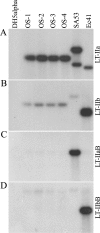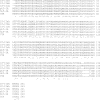LT-IIc, a new member of the type II heat-labile enterotoxin family encoded by an Escherichia coli strain obtained from a nonmammalian host
- PMID: 20713622
- PMCID: PMC2976314
- DOI: 10.1128/IAI.00730-10
LT-IIc, a new member of the type II heat-labile enterotoxin family encoded by an Escherichia coli strain obtained from a nonmammalian host
Abstract
Two families of bacterial heat-labile enterotoxins (HLTs) have been described: the type I HLTs are comprised of cholera toxin (CT) of Vibrio cholerae, LT-I of Escherichia coli, and several related HLTs; the type II HLTs are comprised of LT-IIa and LT-IIb. Herein, we report LT-IIc, a new type II HLT encoded from an enterotoxigenic E. coli (ETEC) strain isolated from an avian host. Using a mouse Y1 adrenal cell bioassay, LT-IIc was shown to be less cytotoxic than CT, LT-IIa, or LT-IIb. Cytotoxicity of LT-IIc was partially neutralized by antisera recognizing LT-IIa or LT-IIb but not by anti-CT antiserum. Genes encoding putative A polypeptide and B polypeptides of LT-IIc were arranged in an operon which was flanked by potential prophage sequences. Analysis of the nucleotide and predicted amino acid sequences demonstrated that the A polypeptide of LT-IIc has moderate homology to the A polypeptides of CT and LT-I and high homology to the A polypeptides of LT-IIa and LT-IIb. The B polypeptide of LT-IIc exhibited no significant homology to the B polypeptides of CT and LT-I and only moderate homology to the B polypeptides of LT-IIa and LT-IIb. The binding pattern of LT-IIc for gangliosides was distinctive from that of either LT-IIa or LT-IIb. The data suggest that other types of the type II HLT subfamily are circulating in the environment and that host specificity of type II HLT is likely governed by changes in the B polypeptide which mediate binding to receptors.
Figures







Similar articles
-
The chromosomal nature of LT-II enterotoxins solved: a lambdoid prophage encodes both LT-II and one of two novel pertussis-toxin-like toxin family members in type II enterotoxigenic Escherichia coli.Pathog Dis. 2016 Apr;74(3):ftw001. doi: 10.1093/femspd/ftw001. Epub 2016 Jan 10. Pathog Dis. 2016. PMID: 26755534 Free PMC article.
-
Type II heat-labile enterotoxins from 50 diverse Escherichia coli isolates belong almost exclusively to the LT-IIc family and may be prophage encoded.PLoS One. 2012;7(1):e29898. doi: 10.1371/journal.pone.0029898. Epub 2012 Jan 5. PLoS One. 2012. PMID: 22242186 Free PMC article.
-
Characterization of the ganglioside recognition profile of Escherichia coli heat-labile enterotoxin LT-IIc.Glycobiology. 2022 Apr 21;32(5):391-403. doi: 10.1093/glycob/cwab133. Glycobiology. 2022. PMID: 34972864 Free PMC article.
-
Cholera toxin, LT-I, LT-IIa and LT-IIb: the critical role of ganglioside binding in immunomodulation by type I and type II heat-labile enterotoxins.Expert Rev Vaccines. 2007 Oct;6(5):821-34. doi: 10.1586/14760584.6.5.821. Expert Rev Vaccines. 2007. PMID: 17931161 Free PMC article. Review.
-
Review of Newly Identified Functions Associated With the Heat-Labile Toxin of Enterotoxigenic Escherichia coli.Front Cell Infect Microbiol. 2019 Aug 13;9:292. doi: 10.3389/fcimb.2019.00292. eCollection 2019. Front Cell Infect Microbiol. 2019. PMID: 31456954 Free PMC article. Review.
Cited by
-
The chromosomal nature of LT-II enterotoxins solved: a lambdoid prophage encodes both LT-II and one of two novel pertussis-toxin-like toxin family members in type II enterotoxigenic Escherichia coli.Pathog Dis. 2016 Apr;74(3):ftw001. doi: 10.1093/femspd/ftw001. Epub 2016 Jan 10. Pathog Dis. 2016. PMID: 26755534 Free PMC article.
-
A Novel Cytotoxic Mechanism for Triple-Negative Breast Cancer Cells Induced by the Type II Heat-Labile Enterotoxin LT-IIc through Ganglioside Ligation.Toxins (Basel). 2024 Jul 11;16(7):311. doi: 10.3390/toxins16070311. Toxins (Basel). 2024. PMID: 39057951 Free PMC article.
-
Type II heat-labile enterotoxins: structure, function, and immunomodulatory properties.Vet Immunol Immunopathol. 2013 Mar 15;152(1-2):68-77. doi: 10.1016/j.vetimm.2012.09.034. Epub 2012 Sep 26. Vet Immunol Immunopathol. 2013. PMID: 23137790 Free PMC article. Review.
-
Type II heat-labile enterotoxins from 50 diverse Escherichia coli isolates belong almost exclusively to the LT-IIc family and may be prophage encoded.PLoS One. 2012;7(1):e29898. doi: 10.1371/journal.pone.0029898. Epub 2012 Jan 5. PLoS One. 2012. PMID: 22242186 Free PMC article.
-
Design of a multi-epitope vaccine against SARS-CoV-2 using immunoinformatics approach.Int J Biol Macromol. 2020 Dec 1;164:871-883. doi: 10.1016/j.ijbiomac.2020.07.117. Epub 2020 Jul 15. Int J Biol Macromol. 2020. PMID: 32682041 Free PMC article.
References
-
- Blanco, J. E., and M. Blanco. 1993. Escherichia coli enterotoxigenicos, necrotoxigenicos y verotoxigenicos de origen humano e bovino—pathogenesis epidemiologia y diangostico microbiologico. Servicio de Publicaciones Diputacion Provincial San Marcos, Lugo, Spain.
-
- Chaudhuri, R. R., M. Sebaihia, J. L. Hobman, M. A. Webber, D. L. Leyton, M. D. Goldberg, A. F. Cunningham, A. Scott-Tucker, P. R. Ferguson, C. M. Thomas, G. Frankel, C. M. Tang, E. G. Dudley, I. S. Roberts, D. A. Rasko, M. J. Pallen, J. Parkhill, J. P. Nataro, N. R. Thomson, and I. R. Henderson. 2010. Complete genome sequence and comparative metabolic profiling of the prototypical enteroaggregative Escherichia coli strain 042. PLoS One 5:e8801. - PMC - PubMed
Publication types
MeSH terms
Substances
Grants and funding
LinkOut - more resources
Full Text Sources
Medical
Research Materials

